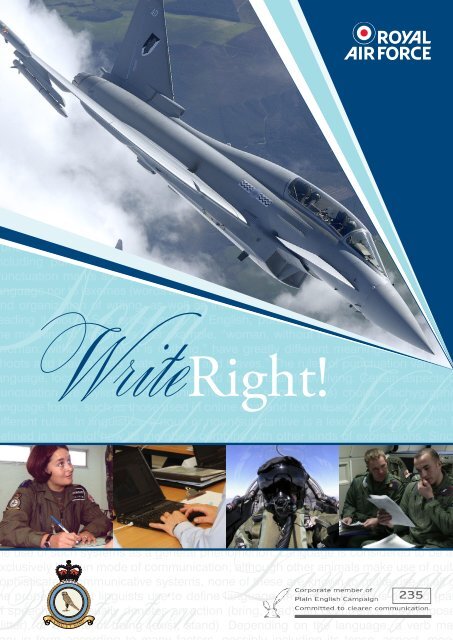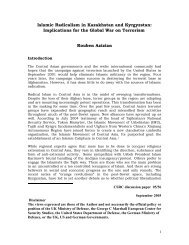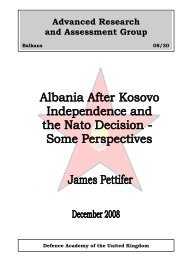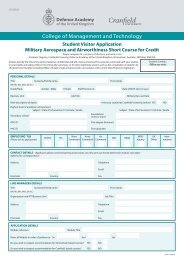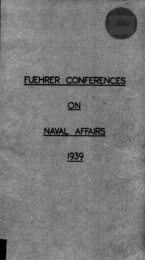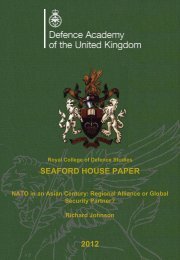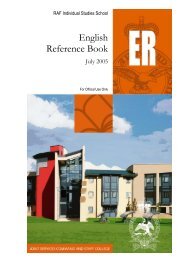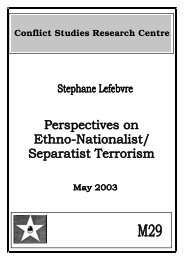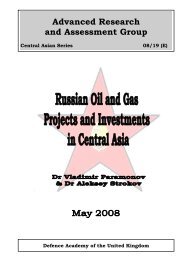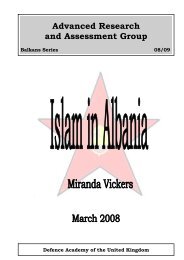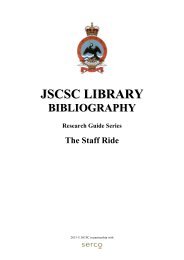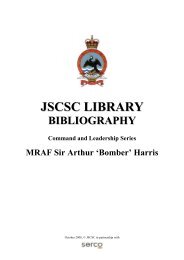Write Right - Defence Academy of the United Kingdom
Write Right - Defence Academy of the United Kingdom
Write Right - Defence Academy of the United Kingdom
- No tags were found...
You also want an ePaper? Increase the reach of your titles
YUMPU automatically turns print PDFs into web optimized ePapers that Google loves.
VI S UE TNI S U
ContentsIntroduction………………………………..………………………………..What is effective writing? …………….…………………………….……..House Style…………………………………………………………………Structure what you want to say………………………………..………….Style………………………………………………………………………….Grammar…………………………………………………………………….Vocabulary…………………………………………………………………..The sentence and <strong>the</strong> paragraph……………………………..………….Americanisms………………………………………………….…………...Clichés, metaphors and similes………………………………………......Some phrases we could easily do without ……………………………...Foreign words……………………………………………………………….Gender……………………………………………………………………….Jargon ……………………………………………………………………...Slang…………………………………………………………………………Tautology……………………………………………………………………Punctuation…………………………………………………………………The apostrophe……………………………………………………………..Brackets……………………………………………………………………..The colon……………………………………………………………………The semicolon………………………………………………………………3467891011121314151617181920212223241
The comma………………………………………………………………….The dash……………………………………………………………………The exclamation mark…………..…………………………………………The full stop…………………………………………………………………The hyphen…………………………………………………………………The question mark…………………………………………………………Quotation marks……………………………………………………………Initial capitals……………………………………………………………….Double trouble………………………………………………………………Pairs and snares……………………………………………………………Which word?........................................................................................Could, would and should………………………………………………….A hundred words which are sometimes mispelt (sic)!..........................Words which are sometimes used wrongly…………………………….Some rules that aren’t really rules ………………………………………Parts <strong>of</strong> speech…………………………………………………………….DW conventions……………………………………………………………Recommended reading……………………………………………………Useful websites…………………………………………………………….252627282930313234353637383940424751512
What is effective writing?Some people would say that writing is effective as long as it isgrammatically correct. But grammatically correct sentences don’talways make sense. If grammatically correct was <strong>the</strong> only thing weneeded to worry about <strong>the</strong> following 2 passages would be alright.A meeting to discuss <strong>the</strong> use <strong>of</strong> <strong>the</strong> Stn squash courts as atemporary morgue during Exercise BLOWHARD will take place at1000 in <strong>the</strong> Stn Conference Room. All interested bodies are invitedto attend.Cpl Barber was only slightly injured when attacked by a fellow doghandler’s Alsatian. The OIC RAF Police said <strong>the</strong> dog would begiven ano<strong>the</strong>r chance.Both passages are grammatically correct, and we may think that weknow what <strong>the</strong> authors meant. But because <strong>the</strong> meaning is ambiguous<strong>the</strong> writing cannot be described as effective.To make up sound yet useable hard-and-fast rules for effective writing isvery difficult. With English <strong>the</strong>re is <strong>of</strong>ten no single correct method <strong>of</strong>putting things; ideas can usually be expressed in several different ways.Also, English is a living language in that it changes over time. So ifenough people were to say we was for long enough, it would eventuallyreplace we were as <strong>the</strong> accepted form.It is perhaps better if we say that:Writing is effective if it achieves <strong>the</strong> purpose that <strong>the</strong> writerintended.In this booklet we <strong>of</strong>fer guiding principles that will help you to writeeffectively. They are not strictly rules; rules, as <strong>the</strong> old proverb goes, are‘for <strong>the</strong> guidance <strong>of</strong> wise men and <strong>the</strong> obedience <strong>of</strong> fools’. Let’s start bylooking at exactly what it is that makes writing effective.4
Here are some objectives that effective writing can be used to achieve:to give informationto obtain informationto persuadeto recordto bring about actionto seek commentWriting is not usually something that we do for ourselves; it is nearlyalways aimed at creating a response in a reader. Some writers seewriting as an opportunity to impress. Showing how intellectual <strong>the</strong>y canbe and how expansive <strong>the</strong>ir vocabulary is, <strong>of</strong>ten at <strong>the</strong> expense <strong>of</strong> <strong>the</strong>irreaders understanding. A simple direct message that is clear and to <strong>the</strong>point is easy for all to understand.Effective written communication is a very useful means <strong>of</strong> gettingbusiness done. Effective writing is largely about simplicity <strong>of</strong> expression,accurate content and brief style. Clear writing reflects clear thinking.Standard formats, <strong>of</strong>ten called ‘house styles’, help to provide structure toa document and ensure that you don't leave out key elements <strong>of</strong>information.When do you need to write? You need to write if:A record has to be kept to account for expenditure or to recordfinancial or o<strong>the</strong>r important decisions.Information or a decision has to be passed to a wide audience.Your message is too detailed or complex to deliver verbally or mayneed to be studied carefully.Things to bear in mind. When you write anything, bear in mind <strong>the</strong>following points:What is <strong>the</strong> purpose <strong>of</strong> <strong>the</strong> document?Who are you writing to?What is <strong>the</strong> most appropriate style?5
VocabularyThe type <strong>of</strong> writing you use will vary depending on who you are writingto. It may be that you are writing to a Service colleague, an <strong>of</strong>ficial in agovernment department, or a member <strong>of</strong> <strong>the</strong> public. No matter who <strong>the</strong>recipient is, certain principles apply to all writing:Use language that is familiar ra<strong>the</strong>r than starchy and old fashioned.Keep it simple so that everyone will understand. Use phrases likeeasy to use instead <strong>of</strong> user friendly and words like latest instead <strong>of</strong>state <strong>of</strong> <strong>the</strong> art.Prefer a single word ra<strong>the</strong>r than a wordy phrase. Often, scarceand so mean <strong>the</strong> same as in several instances, in short supply andwith <strong>the</strong> result that.Listed below are some alternatives that you may find useful.Why say...?a majority <strong>of</strong>a proportion <strong>of</strong>at <strong>the</strong> present timeconsequentlyfur<strong>the</strong>rmorein order toin <strong>the</strong> event thatin <strong>the</strong> neighbourhood <strong>of</strong>provided that<strong>the</strong> question as to whe<strong>the</strong>r<strong>the</strong>re is reason to believewhe<strong>the</strong>r or notwith <strong>the</strong> minimum <strong>of</strong> delayyour attention is drawn to <strong>the</strong> fact (that)When you could say...mostsomenowsoalsotoifabout, or near toifwhe<strong>the</strong>rwe thinkwhe<strong>the</strong>rquicklyplease noteCheck out <strong>the</strong> Plain English Campaign’s A-Z Guide <strong>of</strong> alternative wordson <strong>the</strong>ir website: www.plainenglish.co.uk10
The sentence and <strong>the</strong> paragraphShort sentences are easier to write and to understand than long ones.Remember your objective when writing is to make it as easy as possiblefor your reader to get your message. Don't overload your writing withconditions, exceptions and consequences - <strong>the</strong>se can swamp yourmeaning and bore your reader. Poor writing <strong>of</strong>ten results from sentencesbeing too long. A sensible average might be between 15 and 20 words.Vary <strong>the</strong> length <strong>of</strong> your sentences. Short punchy sentences can be astiring to read as long and verbose ones. Several consecutive sentenceswith <strong>the</strong> same number <strong>of</strong> words can be monotonous.A formal sentence should consist <strong>of</strong> at least a subject and a verb, butneed contain no more, so that Sue laughed is a grammatically correctsentence.The paragraph has 2 roles:To help <strong>the</strong> reader follow your argument by indicating where you aremoving on from one point to ano<strong>the</strong>r.To break up <strong>the</strong> appearance <strong>of</strong> <strong>the</strong> page and make it look morereadable (long paragraphs discourage readers before <strong>the</strong>y start).With too many paragraphs your writing will look jerky; but with too few,<strong>the</strong> reader has no breathing space.11
AmericanismsThe English and American language and literature are both goodthings; but <strong>the</strong>y are better apart than mixed.H W FowlerIf we took Fowler's recommendation to heart we would throw out wordslike teenager, commuter, bluff, boom, stunt and hundreds <strong>of</strong> o<strong>the</strong>rAmerican words which have found a place in our language. Ourlanguage has been derived from many different influences: America isjust one <strong>of</strong> <strong>the</strong>se. However British English has a habit <strong>of</strong> rejecting thoseinfluences that it doesn't like. Using Americanisms can irritate people,and you should try to avoid doing that, particularly in <strong>of</strong>ficial writing. Hereare a few examples:Americanaffirmative actioncounterclockwise…back <strong>of</strong>…letter carrier…fix up…prior to…prioritize…zip code…veteran…additionally…ball park figure…corporation…Britishpositive discriminationanticlockwise…behind…postman…arrange…before…give priority to…post code…ex–serviceman…and…approximate…companyAmerican English is very fond <strong>of</strong> what is called <strong>the</strong> verbal phrase. Butverbal phrases are only useful if <strong>the</strong>y mean something different from <strong>the</strong>simple verb; o<strong>the</strong>rwise <strong>the</strong>y just clutter a sentence. Examples are:Check up on.Face up to.Miss out on.Meet up with.Visit with.(check)(face)(miss)(meet)(visit)All <strong>the</strong>se verbs do <strong>the</strong>ir job better if left alone.12
Clichés, metaphors and similesClichés. A cliché is an overused expression or idea: a phrase or wordthat has lost its original effectiveness or power from overuse. We useclichés because we think <strong>the</strong>y somehow add colour and vigour to ourwriting - but <strong>the</strong>y don't. Expressions such as at one fell swoop and <strong>the</strong>world's my oyster would have sounded refreshingly new whenShakespeare first coined <strong>the</strong>m - but not any more.Should we stop using clichés? No. Just think twice before rolling out anover-familiar phrase, and <strong>the</strong>n use it only if you can’t think <strong>of</strong> a better wayto express what you want to say.Metaphors. A metaphor is an implicit comparison: <strong>the</strong> application <strong>of</strong> aword or phrase to somebody or something that is not meant literally butto make a comparison. For example saying that somebody is a snake ora business is a bit <strong>of</strong> a lame duck is speaking metaphorically.Beware <strong>of</strong> mixed metaphors! This is <strong>the</strong> application <strong>of</strong> 2 or moreinconsistent metaphors to a given situation, for example ‘<strong>the</strong> leadershiphave gone over <strong>the</strong> top and taken up fully entrenched positions’ or ‘incoal mines, mice are used as human guinea pigs’. Mixed metaphorscreate confusing imagery and distract <strong>the</strong> reader from your message.Similes. A simile is a figure <strong>of</strong> speech that draws a comparison between2 different things, especially a phrase containing <strong>the</strong> word ‘like’ or ‘as’, forexample ‘she stood like <strong>the</strong> image <strong>of</strong> <strong>the</strong> muse’ or ‘as white as a sheet’.By all means make your writing colourful and imaginative, but knowwhere to draw <strong>the</strong> line – especially in <strong>of</strong>ficial documents.McMurphy fell 12 floors, hitting <strong>the</strong> pavement like a paper bag filledwith vegetable soup.13
Some phrases we could easily do withoutas a matter <strong>of</strong> fact…at <strong>the</strong> end <strong>of</strong> <strong>the</strong> day…at this moment in time…in <strong>the</strong> final analysis…in view <strong>of</strong> <strong>the</strong> fact that…it should be understood…last but not least…o<strong>the</strong>r things being equal…<strong>the</strong> fact <strong>of</strong> <strong>the</strong> matter is…to all intents and purposes…what can only be described as…when all's said and done…that said…with due regard to….14
Foreign wordsSome originally foreign words such as brochure (French) and arsenal(Arabic) have been thoroughly absorbed into our language. Many more- vice versa (Latin), vendetta (Italian), kudos (Greek) - have becomewell-established and well understood. There are o<strong>the</strong>rs, however, whichare borderline: understood by some but not all. It is this last group whichposes problems. A reader confronted by a Latin tag or foreign phrasefeels irritated if he or she doesn't understand it, and doubly irritated if it'sbeen used in <strong>the</strong> wrong way.Listed below are some foreign phrases and <strong>the</strong>ir English alternatives.ad hoc (Latin)carte blanche (French)cri de coeur (French)fait accompli (French)glasnost (Russian)modus vivendi (Latin)prima facie (Latin)volte face (French)schadenfreude (German)zeitgeist (German)for a special purposea free handheartfelt appealalready doneopennessway <strong>of</strong> livingat first sightreversal <strong>of</strong> opinionpleasure from ano<strong>the</strong>r’s misfortune<strong>the</strong> mood <strong>of</strong> a period <strong>of</strong> historyBefore using a foreign word or phrase you should be confident yourreader will understand and appreciate it. If in doubt find a simple Englishexpression that does <strong>the</strong> job as well.Cave quid dicis, quando, et cui15
JargonIn a calm market <strong>the</strong> cash burn rates could indicate negative cashflow benefits resulting in a management dehire programme.AnonJargon consists <strong>of</strong> <strong>the</strong> technical terms used by specialised groups. Asan expert-to-expert form <strong>of</strong> communication it can save a great deal <strong>of</strong>time. There’s no problem so long as one pilot is speaking to ano<strong>the</strong>rabout <strong>the</strong> effects <strong>of</strong> vertical envelopment or a trainer is writing to acolleague about <strong>the</strong> cognitive domain. It is only when such terms spillover into general communication that <strong>the</strong> writer should think hardwhe<strong>the</strong>r to explain <strong>the</strong>m or look for more understandable alternatives.Jargon is a style <strong>of</strong> writing <strong>of</strong> which management consultants have, fairlyperhaps, been accused <strong>of</strong> being <strong>the</strong> chief exponents. The MOD is alsooccasionally guilty <strong>of</strong> using jargon.Defined and minimalist levels <strong>of</strong> commonality will facilitatemaximum intra-operability and interoperability, leading to enhancedcontextualisation and fusion <strong>of</strong> best practice.Translated this becomes:We need to agree <strong>the</strong> best ways to work. This will help peoplework well in <strong>the</strong>ir own, or o<strong>the</strong>r, departments.Also try to avoid fashionable words if at all possible. Words and phraseslike:Drill down, synergy, critical mass, quantum leap, ducks in a row,ramp up, no brainer, big ask, 24/7 and JFDI!.At its worst, jargon lends itself easily to evasive answers and coldheartedness.You should avoid it as much as you can, especially whenwriting to people outside <strong>the</strong> MOD.17
SlangNew slang flows into <strong>the</strong> language all <strong>the</strong> time, enlivening and stirring upour speech. This would be fine if only we disposed <strong>of</strong> <strong>the</strong> used-up slangat <strong>the</strong> same rate. But we don’t. It hangs around long after its charm hasgone, just cluttering <strong>the</strong> national vocabulary. An example <strong>of</strong> this is <strong>the</strong>expression in <strong>the</strong> red, which goes back to <strong>the</strong> days when bankstatements showed overdrawn accounts in red. They no longer do so,but in <strong>the</strong> red still lingers on.Rhyming slang should also be avoided because, although amusing, itrequires your readers to know <strong>the</strong> code being used before <strong>the</strong>y canunderstand what you are saying.He’s been having some trouble with his chalfonts!Chalfonts Noun. Haemorrhoids. Rhyming slang. From Chalfont StGiles, a town in Buckinghamshire, rhyming with piles.Phil Vickery, <strong>the</strong> England Rugby Captain, left <strong>the</strong> pitch covered inclaret.Claret Noun. Blood. From its colour.Different styles <strong>of</strong> language are appropriate for different forms <strong>of</strong>communication. In speech, unless we are making a special effort, wetend to use slang reasonably freely, be inexact, ungrammatical and a bitsloppy. But slang in our <strong>of</strong>ficial writing is ano<strong>the</strong>r matter; it rarely helpscommunication. It is ei<strong>the</strong>r old or new. If old, <strong>the</strong>n it's stale and boring; ifnew, <strong>the</strong>n it may not be understood by o<strong>the</strong>rs. It is far better to leaveslang to spoken English unless you know your reader well.18
TautologyThey laughed happily as <strong>the</strong>y collaborated toge<strong>the</strong>r on <strong>the</strong> project.AnonTautology is <strong>the</strong> repetition <strong>of</strong> <strong>the</strong> same idea or meaning in a phrase orsentence, as in a free gift (all gifts are free), a new innovation and lonelyisolation. We tend to commit this fault when we want to be emphatic.Avoid for instance, associating most or very with such words as ideal orperfect, which are <strong>the</strong>mselves <strong>the</strong> highest degree possible. Soexpressions such as exclusive monopoly or most absolute would also bewrong.Here are some examples. Redundant words are shown in brackets:The work <strong>of</strong> this branch is not limited (only) to legal matters.Only one additional (new) pilot has joined <strong>the</strong> sqn.The regiment returned (back) to its starting point.The reason is (because) <strong>the</strong>re are none left.We continued (on) with our 2 (fellow) companions.The Stn Cdr is in a position <strong>of</strong> (lonely) isolation.The words in brackets can be dropped from <strong>the</strong>ir sentence without anyloss <strong>of</strong> sense because <strong>the</strong>ir meanings are contained in o<strong>the</strong>r words. Thiskind <strong>of</strong> tautology is not good style and you should avoid it, especially inwriting.19
PunctuationPunctuation is <strong>the</strong> use <strong>of</strong> commas, semicolons, apostrophes, questionmarks and so on, for grammatical or o<strong>the</strong>r purposes. Withoutpunctuation, most written or printed text would make little sense:a year ago polly perkss bro<strong>the</strong>r marched <strong>of</strong>f to battle nowpollys willing to resort to drastic measures to find him so she cuts<strong>of</strong>f her hair dons masculine garb and aided by a well placed pair <strong>of</strong>socks sets out to join this mans armyUsed correctly punctuation can make your writing flow easily, impressyour reader and deliver your message in a clear and pr<strong>of</strong>essionalmanner.Punctuation is a powerful tool and can also change <strong>the</strong> meaning <strong>of</strong> asentence:These are my daughters. (2 or more daughters).These are my daughter’s. (Things that belong to my daughter).An English pr<strong>of</strong>essor asked 2 groups <strong>of</strong> students, one male and onefemale, to punctuate <strong>the</strong> sentence ‘A woman without her man is nothing.’Not surprisingly <strong>the</strong> male group came up with:A woman, without her man, is nothing!However <strong>the</strong> female group had:A woman: without her, man is nothing!The same words, but with different punctuation, <strong>the</strong> whole meaning ischanged!20
The colonConscience: <strong>the</strong> inner voice which tells us someone may bewatching.H L MenckenFowler considered <strong>the</strong> colon's special function was ‘to deliver <strong>the</strong> goodsthat have been invoiced in <strong>the</strong> preceding words.’ The colon indicates afuller pause than <strong>the</strong> semicolon and is now used almost exclusively toprecede lists, summaries or quotations. Normally in English you shouldmake sure that what you write before <strong>the</strong> colon is grammaticallycomplete:The Warsaw Pact comprised 7 countries: <strong>the</strong> USSR, EastGermany, Poland, Hungary, Czechoslovakia, Romania andBulgariaHe briefly outlined a few <strong>of</strong> <strong>the</strong> problems facing <strong>the</strong> project: lack <strong>of</strong>agreed guidelines, disputes within management, shortage <strong>of</strong> staff,rising costs and collapsing moraleHowever, DW convention allows us to use a grammatically incompletestatement before <strong>the</strong> colon when it is used to introduce sub-paragraphs,but only provided that <strong>the</strong> statement is completed grammatically by eachsubsequent sub-paragraph in its entirety. No such sub-paragraph mayei<strong>the</strong>r have a heading or contain an additional sentence. Subparagraphs,whe<strong>the</strong>r consisting <strong>of</strong> single words, phrases or clauses,must all be <strong>of</strong> similar construction.The colon can also be used to separate 2 statements in order toemphasise <strong>the</strong> contrast between <strong>the</strong>m:Man proposes: God disposes.23
The semicolonThe semicolon marks a longer pause than a comma, but a shorter onethan a full stop. It is useful:As a means <strong>of</strong> avoiding confusion in lists.The guests included Colonel Blanchard, leader <strong>of</strong> <strong>the</strong>expedition; Major Fielding, his chief assistant; Captain Buck,<strong>the</strong> technical adviser; ...To separate 2 or more clauses which are <strong>of</strong> more or less equalimportance and are linked as a pair or a series.The idea <strong>of</strong> including ethnic groups in emerging governmentsis both bold and potentially fruitful; moreover it is nowpossible.To emphasise a contrast.On this occasion I will let your insubordination gounpunished; but in future I will not be so lenient.If you are uncertain about <strong>the</strong> semicolon, avoid it; however correctly usedit can be a very effective punctuation mark.24
The commaAll generalisations are dangerous, even this one.Alexandre DumasAlthough <strong>the</strong> rules for using <strong>the</strong> comma are really very simple, it isfrequently used wrongly. Forget anything you've ever been told aboutusing a comma "wherever you would pause", or anything <strong>of</strong> <strong>the</strong> sort; thiswell-meaning advice is hopelessly misleading. The comma tends to beused ei<strong>the</strong>r too <strong>of</strong>ten or not enough. There are 3 distinct uses for acomma:To separate each item in a list.In his backpack Sgt Jarvis carried his mess tins, a sleepingbag, some dry socks and a copy <strong>of</strong> Sun Tzu’s ‘The Art <strong>of</strong> War’.Where <strong>the</strong>re is a danger <strong>of</strong> ambiguity or doubt (and should bepreceded by a comma).The train will stop at Harrow, Pinner, Watford, and Bushey.O<strong>the</strong>rwise Watford and Bushey might be interpreted as one station(like Bushey and Oxhey).As a pair to enclose words that can be left out without affecting <strong>the</strong>grammatical structure <strong>of</strong> <strong>the</strong> sentence.Cpl Davis, a former member <strong>of</strong> 304 Sqn, was accused <strong>of</strong> settingfire to <strong>the</strong> hangar.To separate clauses in a sentence.This brief outlines Britain's defence policy, examines NATO'sstrategy, and considers <strong>the</strong> problems facing <strong>the</strong> Alliance.25
The dashWar does not determine who is right – only who is left.Bertrand RussellThe dash tends to be overused by lazy writers who see it as an allpurposepunctuation mark. It should not replace commas, colons,brackets, and so on. The dash has 3 main uses:To show a sudden break or shift in thought.I shall be in early tomorrow - if my train is on time - tohelp you prepare for <strong>the</strong> meeting.After a multiple subject.Integrity, sincerity, honesty - <strong>the</strong>se are just 3 <strong>of</strong> <strong>the</strong> qualitiesyou need to fake to be a politician.To insert a remark into a sentence which is already grammaticallycomplete.The main reason for <strong>the</strong> Minister's decision - and this has s<strong>of</strong>ar not been mentioned - is that <strong>the</strong> economic situationdemands it.Some people used to add a dash after a colon (:-). This use is archaicand should be avoided.26
The exclamation markThe exclamation mark denotes <strong>the</strong> expression <strong>of</strong> surprise or strongfeeling. It can be used:After exclamations, especially those beginning with what or how.What a day!How amazing!That’s fantastic!Aaarrgh!After a statement considered surprising by <strong>the</strong> writer.They met on Monday and were married on Friday!After months <strong>of</strong> work <strong>the</strong> tomb was opened. It was empty!After emphatic commands, exhortations and wishes.Drop it!Come and join us!Long live <strong>the</strong> Queen!Tyronne, don’t touch that!Although it is widely used by sports writers, <strong>the</strong> exclamation mark, like<strong>the</strong> dash, has little place in <strong>of</strong>ficial writing. Using <strong>the</strong>m frequently willgive your work a breathless, almost childish quality.Don’t use an exclamation mark unless you’re sure it’s necessary – andnever use 2 or 3 <strong>of</strong> <strong>the</strong>m in a row!!27
The full stop‘Where shall I begin, your majesty?’ ‘Begin at <strong>the</strong> beginning,’ <strong>the</strong>king said gravely, ‘and go on till you come to <strong>the</strong> end, <strong>the</strong>n stop.’Lewis CarrollThe full stop is one punctuation mark which most <strong>of</strong> us could well usemore <strong>of</strong>ten. Even so, if used too much it will give your writing a stiltedlook.Please call me at <strong>the</strong> <strong>of</strong>fice tomorrow. I have something todiscuss. I shall be in by 0900. It will not take long.This would read better as:Please call me tomorrow, as I have something to discuss. I shall bein by 0900 and it will not take long.In standard English, as well as ending a normal sentence, you will seefull stops used with abbreviations that do not end with <strong>the</strong> same letter as<strong>the</strong> unshortened form.Capt. (captain)Min. (minimum)Max. (maximum)But not where <strong>the</strong> shortened form ends with <strong>the</strong> same letter as <strong>the</strong>complete word.Ft (feet)St (Street)Revd (Reverend)It is not usual practice to have full stops with such familiar abbreviationsas USA, BBC or RAF.Note: This practice is not <strong>the</strong> convention that we use in <strong>the</strong> military andJSP 101 states that you should not use punctuation within or afterabbreviations, except when it is part <strong>of</strong> normal sentence construction.For example, use Dr and eg not Dr. or e.g.28
The hyphenA well-tied tie is <strong>the</strong> first serious step in life.Oscar WildeFowler's Modern English Usage devotes about 1000 words to <strong>the</strong>hyphen! We won't detain you quite that long; but a few points would behelpful. The hyphen should be used:Where its absence could lead to misunderstanding.In India he shot a man-eating tiger. (He shot a tiger which atemen.)In India he shot a man eating tiger. (He shot a man who waseating tiger meat.)Where it makes <strong>the</strong> meaning clear.This department contains sixty-odd people. (Without ahyphen this would read very strangely).With compound adjectives.Face-saving.Public-spirited.Red-hot.Dark-blue.Some word combinations are hyphenated when <strong>the</strong>y come before anoun, but not when <strong>the</strong>y come after.It is an out-<strong>of</strong>-date system. But: The system is out <strong>of</strong> date.This is a long-term problem. But: The problem is long term.29
Geographical titles or regions. France, Rome, Rhine, Pacific,Lower Rhine, North Wales and South London.National titles. Norwegian, Dutch, Jew, Protestant.Titles <strong>of</strong> organizations and buildings. RAF Division, JointServices Command and Staff College. If you repeat <strong>the</strong> title inshortened form, continue to use initial capitals: <strong>the</strong> Division islocated at <strong>the</strong> College.Days and months. Thursday, New Year’s Day or November.Government departments and agencies. The Ministry <strong>of</strong><strong>Defence</strong>.Ranks, pr<strong>of</strong>essions and appointments. When writing <strong>of</strong> onespecific person (Col Smith was one <strong>of</strong> 4 cols present). Dr Brownwas using one <strong>of</strong> <strong>the</strong> doctors’ surgeries.Titles and names. For <strong>the</strong> first word and for all important wordsin titles <strong>of</strong> books, essays, films, and so on (The Holy Bible, ThePleasures <strong>of</strong> Reading, Gone with <strong>the</strong> Wind). Use initial capitals for<strong>the</strong> names <strong>of</strong> historical events, periods and documents (SecondWorld War, The Stone Age, Magna Carta).Paragraph headings. For <strong>the</strong> first word in paragraph and subparagraphheadings and in each item in a list <strong>of</strong> annexes,references and so on.33
Double troubleSome word combinations just seem wrong. If you are able to spot <strong>the</strong>secombinations easily, so much <strong>the</strong> better. If you can’t <strong>the</strong>n watch out for<strong>the</strong> following:Double superlativesWrong: My schooldays were <strong>the</strong> most happiest days <strong>of</strong> my life.<strong>Right</strong>: My schooldays were <strong>the</strong> happiest days <strong>of</strong> my life.Double comparativesWrong: I was more happier <strong>the</strong>n than at any time since.<strong>Right</strong>: I was happier <strong>the</strong>n than at any time since.Double past tensesWrong: I would have liked to have gone.<strong>Right</strong>: I would have liked to go.Double negativesWrong: I wouldn't be surprised if it didn't start to rain.<strong>Right</strong>: I wouldn't be surprised if it started to rain.A linguistics pr<strong>of</strong>essor was lecturing to his class one day.‘In English,’ he said, ‘A double negative forms a positive. In somelanguages, though, such as Russian, a double negative is still anegative. However, <strong>the</strong>re is no language wherein a double positive canform a negative.’A voice from <strong>the</strong> back <strong>of</strong> <strong>the</strong> room piped up, ‘Yeah, right.’34
Pairs and snaresadverse (unfavourable)affect (to influence)agree to (a plan, a proposal)alternate (every o<strong>the</strong>r)apposite (appropriate)appreciable (noticeable)beside (next to)biannual (twice a year)canvas ( a cloth)complementary (balancing)defective (faulty)exceedingly (outstandingly)flaunt (to show <strong>of</strong>f)ingenious (clever)insidious (cunningly harmful)intense (strong)judicial (relating to law)licence (a permit)luxuriant (abundant)perquisite (additional benefit)practicable (can be achieved)prescribe (to recommend)principal (chief, head)stationary (not moving)stimulant (a drug)summon (to call)swat (to hit an insect)titillate (to arouse mildly)averse (opposed)effect (result, to bring about)agree with (a person)alternative (instead <strong>of</strong>)opposite (facing)appreciative (grateful)besides (as well, also)biennial (every two years)canvass (to seek support)complimentary (admiring)deficient (lacking)excessively (too much)flout (to disregard)ingenuous (without guile)invidious (<strong>of</strong>fensive)intensive (concentrated)judicious (wise, sensible)license (to authorise)luxurious (in luxury)prerequisite (prior condition)practical (useful)proscribe (to ban)principle (rule)stationery (<strong>of</strong>fice supplies)stimulus (an incentive)summons (a legal command)swot (to study hard)titivate (to smarten oneself)35
Could, would and shouldThere is sometimes confusion over when to use could, would andshould.Could is connected with <strong>the</strong> word can. I could can be explained as I can,under certain conditions. Could is, <strong>the</strong>refore, known as <strong>the</strong> conditional <strong>of</strong>can.Similarly ‘should’ is <strong>the</strong> conditional <strong>of</strong> shall and would is <strong>the</strong> conditional <strong>of</strong>will.Could implies a physical possibility without indicating whe<strong>the</strong>r or not <strong>the</strong>action will take place or ought to take place.Should gives <strong>the</strong> idea <strong>of</strong> duty or preference, and can <strong>of</strong>ten be replacedby ought to.Would implies that, under <strong>the</strong> given circumstances, <strong>the</strong> action will takeplace whe<strong>the</strong>r it is desirable or not.If he were stronger he could lift this weight. (He could lift it, but wedo not know whe<strong>the</strong>r he will or ought to).If he were stronger he would lift this weight. (He will lift it, if hebecomes stronger).If he were stronger he should lift this weight. (He ought to lift it, butwe don’t know if he will).As a fur<strong>the</strong>r example, consider <strong>the</strong> following short passage:The visitors could travel by train, but <strong>the</strong>y would <strong>the</strong>n have difficultywith <strong>the</strong>ir luggage and equipment. Therefore a car should beprovided for <strong>the</strong>m.’This passage could be rewritten as:It will be possible for <strong>the</strong> visitors to travel by train. However, if <strong>the</strong>ydo, <strong>the</strong>y will have difficulty with <strong>the</strong>ir luggage and equipment.Therefore a car ought to be provided for <strong>the</strong>m.37
A hundred words which aresometimes mispelt (sic)!accessibleaccessoryaccommodateacquiesceadmissibleadvantageousadvisoryaerialagreeableallegeasymmetricaudibleauxiliarybattalionbenefitedbicyclebulletinbuoyantbureaucalendarcamouflagecampaigncoherentconscientiousconsciouscurriculumdeferreddesultorydeterrenteligibleembarrassmentequippederroneousexistenceexpedientfallacyfeasibleforfeitGibraltargovernorgradientgraffitigrievousharasshumoroushygieneillegibleinaugurateindependenceindispensableinfallibleinferenceinnocuousinoculateinstalmentinstilintractableirrelevantliaisonlieutenantmaintenancemanoeuvremaritimemedievalmortgagenegligiblenoticeableobsoleteoccasionoccurredomittedOttawaoverratedparallelpermissiblepersistentprecedentpr<strong>of</strong>essorpr<strong>of</strong>itedquerulousreconnaissancerefereerhetoricrhythmsatellitesecedeseparatesergeantserviceablesoliloquystupefysupersedetargetedthresholdtransferabletransienttunnellingtwelfthquestionnaireultimatumThe truth about spelling is that some words can be really difficult tospell. Some people find spelling easy and some people find it veryhard. If you are one <strong>of</strong> <strong>the</strong> latter, consult a dictionary or use <strong>the</strong> spellingand grammar checker on your PC – and remember:If GH stands for P as in HiccoughIf OUGH stands for O as in DoughIf PHTH stands for T as in PhthisisIf EIGH stands for A as in NeighbourIf TTE stands for T as in GazetteIf EAU stands for O as in PlateauThen <strong>the</strong> right way to spell POTATO is GHOUGHPHTHEIGHTTEEAU!38
Words which are sometimes usedwrongly...Aggravate. This does not mean <strong>the</strong> same as irritate or exasperate.It means to make a bad situation worse.Alibi. An alibi is a claim to have been elsewhere when an incident tookplace. It is not an alternative word for an excuse.Billion. In Britain a billion used to mean a million million. But now <strong>the</strong>American definition <strong>of</strong> a thousand million is generally accepted.Chronic. Means lingering, lasting, long-established. It does not meanbad, intense or severe.Dilemma. A dilemma is an awkward choice between 2 or more options.It is not a synonym for problem.Leading question. A leading question is a question phrased so as toprompt <strong>the</strong> desired answer. It is not a searching or <strong>the</strong> most importantquestion.Presently. This means soon, not at present or present which mean now.Transpire. It is a common error to use transpire as if it meant happenor occur. What it means is to become known.39
Some rules that aren’t really rulesYou will hear various ‘rules’ banded about by so-called experts inEnglish. Most <strong>of</strong> <strong>the</strong>se are not really rules at all and really fall into <strong>the</strong>category <strong>of</strong> ‘advice to beginners’.And and ButAnd and But may be used to begin ei<strong>the</strong>r a sentence or a paragraph.And why not? If we followed <strong>the</strong> ‘rule’ we would deprive ourselves <strong>of</strong> 2 <strong>of</strong><strong>the</strong> most useful words for connecting sentences smoothly.ContractionsContractions (don't, wouldn't, it's) should be used sparingly. Contractionslend <strong>the</strong>mselves best to an informal style <strong>of</strong> writing. But shunningcontractions completely in <strong>of</strong>ficial writing can have <strong>the</strong> effect <strong>of</strong> making itappear ponderous and remote.Repeating wordsIt is both natural and good that we should try to avoid repeating <strong>the</strong> sameword too <strong>of</strong>ten and too closely toge<strong>the</strong>r. But more important than varietyis clarity. By being over-concerned with finding new words to describe<strong>the</strong> same thing we can end up confusing our reader.Split infinitivesWhen ano<strong>the</strong>r word comes between to and <strong>the</strong> verb (to boldly go, tocarefully consider), that is a split infinitive. Split infinitives used to beconsidered a cardinal sin in good English; but <strong>the</strong>re are some instanceswhere <strong>the</strong>y may be justified. He was asked to discreetly drop a hintwould have a different meaning if changed to He was discreetly asked todrop a hint.Tail-end prepositionsA preposition expresses <strong>the</strong> relationship <strong>of</strong> one word with ano<strong>the</strong>r (<strong>of</strong>,for, below). Normally sentences should not end with prepositions.However, many sentences do naturally end in this way and <strong>of</strong>ten <strong>the</strong>preposition needs to be at <strong>the</strong> end. She is <strong>the</strong> most suitable person I can40
Parts <strong>of</strong> speechEvery word in a sentence is <strong>the</strong>re for a reason. A word in itself cannot beidentified as a particular part <strong>of</strong> speech unless we know what job it isdoing in <strong>the</strong> sentence. The function defines <strong>the</strong> part <strong>of</strong> speech. But becareful; sometimes <strong>the</strong> function is not clear.For example, we might say that ‘salt’ is a noun, meaning a flavouring.But, in <strong>the</strong>se sentences, it performs a different function.The salt (adjective) water may sting your eyes.You must salt (verb) <strong>the</strong> potatoes before you boil <strong>the</strong>m.The old salt (noun) spoke about shipwrecks.You need salt (noun) on fish and chips.In <strong>the</strong> same way, we might say that ‘fast’ is an adjective, as in a ‘fast car’.But again, in <strong>the</strong> following sentences it performs differently.He was driving too fast (adjective).The protesters are on a seven-day fast (noun).We have decided to fast (verb) for Lent.They have included 2 fast (adjective) bowlers in <strong>the</strong> team.VerbsThe function <strong>of</strong> a verb is to show doing, having or being. Verbs havetenses to show when <strong>the</strong>y take place.Present tenseI am speaking to him now.It is raining.I have a picture <strong>of</strong> her here.You are late again.The choir sings superbly.42
Past tenseI spoke to him yesterday.It was raining this morning.I had a picture <strong>of</strong> her.You have been late every day this week.The choir sang last night.Future tenseI will be speaking to him tomorrow.It will rain later.I will have a picture <strong>of</strong> her tomorrow.You will be late.The choir will be singing next week.AdverbsThe main function <strong>of</strong> an adverb is to show how, where or when a verbhappens, such as:Quickly, slowly, sadly, carefully, beautifully, arrogantly.Most adverbs end in -ly, but some don't, such as:Fast, well, <strong>of</strong>ten, now, <strong>the</strong>re, later.Adverbs can also be linked to adjectives or o<strong>the</strong>r adverbs, as in:Completely safe.Totally worn out.Very gently.Too quickly.43
NounsThe function <strong>of</strong> a noun is to name a person, place or thing.There are 4 types <strong>of</strong> noun:Common nouns, such as:Door, car, trees, building, woman, <strong>of</strong>fices.Proper nouns, which are names and begin with a capital letter, suchas:Liverpool, Lillian, France, MOD, Tuesday, January.Abstract nouns, which are things we can't see or touch, such asDecisions, concentration, honour, friendship, bravery, ability.Collective nouns, which are <strong>the</strong> names <strong>of</strong> groups, such as:Teams, crews, herds, audiences, committees, crowds.PronounsPersonal pronouns take <strong>the</strong> place <strong>of</strong> nouns to make sentences run moresmoothly. So:We wrote to <strong>the</strong> manufacturers because <strong>the</strong> manufacturers wereconcerned.becomes:and:becomes:... because <strong>the</strong>y were concerned.Andy was late because Andy was delayed at <strong>the</strong> airport.... because he was delayed...44
SingularPluralfirst person subject I weobject me uspossessive mine ourssecond person subject you youobject you youpossessive yours yoursthird person subject she he it <strong>the</strong>yAdjectivesobject her him it <strong>the</strong>mpossessive hers his its <strong>the</strong>irsThe function <strong>of</strong> an adjective is to describe a noun. Adjectives are wordssuch as:Quick, slow, sad, careful, beautiful, arrogant.ConjunctionsConjunctions are linking words. They can link words, sentences, or parts<strong>of</strong> a sentence.The moon and sea were breathtaking.We tried her number several times. But still <strong>the</strong>re was no reply.We sold your ticket because you failed to pay for it.Some o<strong>the</strong>r common conjunctions are:although, so, until, when, since, as, while and however.45
PrepositionsPrepositions come before nouns or pronouns and usually show aconnection.I left it in <strong>the</strong> car.We went to <strong>the</strong> library.He sat on <strong>the</strong> kitchen table.Some o<strong>the</strong>r common prepositions are:Articlesat, for, up, over, with, by, from, near.There are 2 kinds <strong>of</strong> article: definite and indefinite. The definite article is<strong>the</strong>. The indefinite article is a or an.The ruler.A complaint.An agreement.We use an before a vowel (a, e, i, o, u).We use a before a consonant (<strong>the</strong> o<strong>the</strong>r letters <strong>of</strong> <strong>the</strong> alphabet).But <strong>the</strong>re are exceptions, for example:A unique suggestion.A European country.A useful idea.An MP.An hour.An heir.An hotel.46
DW conventionsThis is a quick reference guide to DW conventions. It does not list all <strong>of</strong><strong>the</strong> conventions, just <strong>the</strong> most commonly used ones. For a full list <strong>of</strong> DWConventions see JSP 101 Chapter 6.Capital letters 1. Normal punctuation rules apply.2. Use a capital letter for Service(s) when it refers to <strong>the</strong> UKarmed forces.3. Use capital letters for code words, and names <strong>of</strong> exercises,projects, operations, Royal Navy ships, protective markings anddescriptors.Paragraphnumbers1. A paragraph has an Arabic number, followed by a full stopand a tab space. The numbering sequence and conventions areshown below:a. A sub-paragraph is block-indented one tab space.b. A sub-paragraph is identified by a lower-case letter,followed by a full stop and a tab space:(1) A sub-sub-paragraph is block indentedano<strong>the</strong>r tab space.(2) A sub-sub-paragraph is identified by anArabic number, in brackets, followed by a tab space:(a) A sub-sub-sub-paragraph is blockindented ano<strong>the</strong>r tab space.(b) A sub-sub-sub-paragraph is identifiedby a lower-case letter, in brackets, followedby a tab space.This represents <strong>the</strong> final part <strong>of</strong> Paragraph 1, and <strong>the</strong> text startsagain at <strong>the</strong> left margin. If you continue <strong>the</strong> paragraph, do not usefur<strong>the</strong>r subdivisions until <strong>the</strong> next paragraph.2. Number <strong>the</strong> next paragraph and start it at <strong>the</strong> left margin.3. If <strong>the</strong>re is only one paragraph in a document, do notnumber it, and start <strong>the</strong> text at <strong>the</strong> left margin. It is not necessaryto use paragraph numbering in letters to a person outside <strong>the</strong>MOD or in letters <strong>of</strong> condolence.4. Text introducing sub-paragraphs ends with a colon.47
Line spacing 1. Use single line spacing for a block <strong>of</strong> text. Leave one blankline above and below subject, main and group headings; andbetween all types <strong>of</strong> paragraphs.2 Leave at least one blank line between <strong>the</strong> last line <strong>of</strong> textand <strong>the</strong> page number.Drafts 1. If sending documents electronically use single line spacing.If sending documents in hard copy use double line spacing for <strong>the</strong>main body <strong>of</strong> <strong>the</strong> text.2. Ei<strong>the</strong>r word ‘DRAFT’, in bold capitals (not underlined), topcentre <strong>of</strong> every page, leaving one clear line below any protectivemarking or descriptor, and one clear line below <strong>the</strong> word ‘DRAFT’3. Or add <strong>the</strong> watermark ‘DRAFT’ by using <strong>the</strong> ‘Format’,‘Background’ ‘Watermark’ facility on your PC.Protectivemarkings anddescriptors4. Use <strong>the</strong> signature block <strong>of</strong> <strong>the</strong> person who will sign <strong>the</strong> finalversion <strong>of</strong> <strong>the</strong> document. Enter <strong>the</strong> month and year <strong>of</strong> <strong>the</strong> date.The person signing will add <strong>the</strong> day when <strong>the</strong> draft is approved.1. In general, always use a protective marking with adescriptor. A protective marking or a descriptor, are written inbold capitals and entered at <strong>the</strong> top and bottom <strong>of</strong> each page.2. In hard-copy documents, repeat <strong>the</strong> protective marking ordescriptor at <strong>the</strong> top and bottom on <strong>the</strong> reverse <strong>of</strong> <strong>the</strong> final pageas well.Originator’sdetailsAddressesFootnotes3. JSP 440 (<strong>the</strong> <strong>Defence</strong> Manual <strong>of</strong> Security) gives guidanceon protective markings, descriptors and how to number copies <strong>of</strong>protected documents.1. The originator’s details must include enough information toallow a recipient to contact <strong>the</strong> sender.2. The details should include <strong>the</strong> originator’s address, phonedialling code and number (normally on both a civilian and militarynetwork), (fax number), email address (Internet or DII), and,where appropriate, <strong>the</strong> signal message address or telexOutside MOD. On letters to people outside <strong>the</strong> MOD, show <strong>the</strong>full postal address <strong>of</strong> <strong>the</strong> originator and <strong>the</strong> recipient.Inside MOD. In letters and documents to MOD addressees, use<strong>the</strong> originator’s full address, but you may use <strong>the</strong> recipient’sabbreviated address: Unit (Job title).Use footnotes (not endnotes) to show references to letters ordocuments, or to provide detail which would o<strong>the</strong>rwise clutter <strong>the</strong>text.48
Signature block 1. Use a signature block to identify <strong>the</strong> person signing adocument. Show <strong>the</strong> initials and name <strong>of</strong> <strong>the</strong> person signing,using upper-case and lower-case letters. Do not include postnominalletters.2. For military staff, show <strong>the</strong> rank <strong>of</strong> <strong>the</strong> person signing.<strong>Write</strong> military ranks with initial capitals only. Include <strong>the</strong> job title <strong>of</strong><strong>the</strong> person signing. You may add <strong>the</strong> job title or department <strong>the</strong>person represents. Check on local practice.3. In loose minutes show originator’s contact details in <strong>the</strong>signature block. Include phone number, room number and emailaddress.Page numbers4. A signature block must never appear by itself at <strong>the</strong> top <strong>of</strong> apage. Leave part <strong>of</strong> <strong>the</strong> previous page blank so that at least oneline <strong>of</strong> text is above <strong>the</strong> signature block.5. Do not include a facsimile signature in <strong>the</strong> signature block Ifyou send a document by email.Put page numbers at <strong>the</strong> bottom centre <strong>of</strong> <strong>the</strong> page, without a fullstop. Single-page documents are not normally numbered.Abbreviations 1. Abbreviations are commonly used for dates, ranks orgrades, job titles, formations and units. O<strong>the</strong>r abbreviations mayonly be used when <strong>the</strong>y are well understood by <strong>the</strong> recipients. Donot use <strong>the</strong> ampersand (&) to replace <strong>the</strong> word ‘and’ in writtenEnglish. Use ‘&’ only in abbreviated titles: ‘R&D’ or ‘P&SS’.2. Do not use abbreviations when <strong>the</strong> tone and purpose <strong>of</strong> adocument make <strong>the</strong>m inappropriate, such as in a citation, alaudatory letter or a letter <strong>of</strong> condolence. If you are thinking <strong>of</strong>abbreviating a word, or words, follow <strong>the</strong>se guidelines:a. Do not overuse abbreviations, or you will make ithard for <strong>the</strong> reader to understand what you have to say.b. Do not introduce an abbreviation if you do not use itagain in <strong>the</strong> document.c. The first time you use <strong>the</strong> word or words, ei<strong>the</strong>r in aheading or in <strong>the</strong> text, write <strong>the</strong>m in full. Then show <strong>the</strong>abbreviation in brackets immediately after; for example ‘<strong>the</strong>hilltop is a key-point (KP) position’.d. Thereafter, use <strong>the</strong> abbreviation consistentlythroughout <strong>the</strong> subsequent text, headings, tables, annexesand appendices.Dates, days andtimeDates. Dates are written in <strong>the</strong> order day, month, year. Do notstart a date with ‘<strong>the</strong>’ or use superscript (‘ th’ ) after <strong>the</strong> day <strong>of</strong> <strong>the</strong>date, and do not use a leading zero with single-digit days. Toabbreviate a date, write <strong>the</strong> number <strong>of</strong> <strong>the</strong> day, <strong>the</strong> first 3 letters <strong>of</strong>49
<strong>the</strong> month (‘Jan’, ‘Feb’ etc), and <strong>the</strong> last 2 digits <strong>of</strong> <strong>the</strong> year.Days. To abbreviate a day <strong>of</strong> <strong>the</strong> week, use only <strong>the</strong> first 3letters <strong>of</strong> <strong>the</strong> day (‘Mon’, ‘Tue’…).Time. Express time in 4 figures by reference to <strong>the</strong> 24-hour clock.Only use <strong>the</strong> suffix ‘hrs’, or a time-zone suffix to avoid confusionwith o<strong>the</strong>r figures. The suffix 'L' means time zone LIMA, not 'localtime'. In correspondence with people outside <strong>the</strong> MOD, use <strong>the</strong>12-hr clock system, followed by ‘am’ or ‘pm’ as appropriate.Numerals,fractions andordinal numbers1. Numerals and fractions. In most circumstances, writenumerals and precise numerical fractions in Arabic figures. Thefollowing conventions also apply:a. Because <strong>the</strong> figure ‘1’ could be confused with <strong>the</strong>letter ‘I’, spell out <strong>the</strong> number ‘one’. Use <strong>the</strong> Arabic figure'1' in dates; page numbers; paragraph, chapter and serialnumbers; titles; measurements; enclosure and appendixnumbers; and in figures, diagrams and tables. If you needto avoid confusion, use ‘zero’ or ‘nought’ instead <strong>of</strong> <strong>the</strong>number ‘0’.b. Where a number starts a sentence or subdivision <strong>of</strong>a paragraph, spell it out: ‘Sixty years after <strong>the</strong> event….’. Ina point brief, you may start a sentence or follow aparagraph numbers or a bullet with a number. When anumber that forms part <strong>of</strong> a title begins a sentence, write itin figures: ‘1 Armd Div is to….’.c. When a number refers to quantitative amount <strong>of</strong>Service formations or units, always spell it out to avoidconfusion. Use ‘three sqns’, not ‘3 sqns’ (which could bemisunderstood to mean ‘No 3 Sqn’)d. Decimal fractions. <strong>Write</strong> a decimal fraction byplacing <strong>the</strong> decimal point on <strong>the</strong> base <strong>of</strong> <strong>the</strong> line: ‘8.346’. If<strong>the</strong> fraction is less than one, place a zero before <strong>the</strong>decimal point: ‘0.346’.e. Marking thousands. Use blank spaces to divide alarge number <strong>of</strong> digits into groups <strong>of</strong> 3, counting from <strong>the</strong>decimal marker: ‘15 762’ or ‘14 945.762 21’. .2. Quantities and dimensions. If you write a quantity and adimension toge<strong>the</strong>r, ei<strong>the</strong>r spell out <strong>the</strong> first number: ‘fifteen2-metre pallets', or separate adjacent numbers by <strong>the</strong>multiplication sign: ‘15 x 2-metre pallets’.3. Ordinal numbers. Ordinal numbers (‘first’, ‘second’ andso on) do not need to be spelt out. The style ‘21 st century’ isacceptable. Do not use ordinal numbers with dates.50
Recommended readingJoint Service Publication (JSP) 101 V3 – The <strong>Defence</strong> Writing Guide.Electronic <strong>Defence</strong> Writing eDW Edition 2.0 Oct 2006.Modern English Usage, revised by Sir Ernest Gowers.The Complete Plain Words, by Gowers (revised 1986).Eats, shoots and leaves, by Lynne Truss.The Good Grammar Guide by Richard PalmerRediscover Grammar by David Crystal.Making Sense <strong>of</strong> Grammar by David Crystal.The Penguin Dictionary <strong>of</strong> English Grammar by R L Trask.The Penguin guide to Punctuation by R L Trask.Useful websitesPlain English Campaign www.plainenglish.co.uk.Economist Good Style Guide www.economist.com/research/styleguide.eDW website www.defac.ac.uk/edw.51


